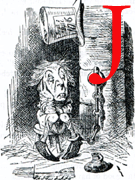 ohn Tenniel, who best known today for his illustrations to the Alice books, was born in London in 1820, the son of a dancing master and fencing instructor. He studied at the schools of the British Royal Academy and at the Clipstone Street Art society, but was largely self-taught as a book illustrator and periodical cartoonist.
ohn Tenniel, who best known today for his illustrations to the Alice books, was born in London in 1820, the son of a dancing master and fencing instructor. He studied at the schools of the British Royal Academy and at the Clipstone Street Art society, but was largely self-taught as a book illustrator and periodical cartoonist.

Portrait of John Teniel from the 1884 Good Words
At the age of 16, he exhibited his first oil painting at the Society of British Artists. In 1840, while fencing with his father, he was blinded in one eye, according to his biographer, F. Sartzano in Sir John Tenniel (1948). In 1845, he was awarded a premium for a sixteen-foot cartoon of The Spirit of Justice, although the Fine Arts Commission awarded Daniel Maclise �250 for the oil painting which sits behind the Strangers' Gallery in Westminster's House of Lords. There in "The Hall of Poets" one may still see Tenniel's fresco illustrating John Dryden's Saint Cecilia.
Some three years younger than Punch regular and Dickens Christmas Book illustrator John Leech (1817-64) and considerably younger than Clarkson Stanfield, R. A. (1793-1867), by the time of his work on Dickens's The Haunted Man Tenniel had already exhibited at the Society of British Artists in 1836 and at the Royal Academy (1837-42). He had also contributed illustrations to The Book of British Birds (1842), his friend Charles Keene's Heath's Book of Beauty (1845), and, most recently, Thomas James's Aesop's Fables (1848).
Since Dickens's usual engraver, L. C. Martin (whose firm was responsible for seven of the 17 Haunted Man plates) was married to Tenniel's sister, it is surprising that Dickens and Tenniel had not met sooner. The year after illustrating The Haunted Man, Tenniel replaced gifted illustrator and fairy-artist Richard Doyle on the staff of Punch when the latter left because as a Catholic he objected to the magazine's attacks on the papacy. At the outset of The Haunted Man project in October 1848, Dickens, not yet aware of Tenniel's capabilities, confined him to ornamental subjects (the frontispiece, the title-page, and the fire-side scene that opens the story proper), and gave over to him what Leech had not the time for, resulting in the extremely wooden renditions of Mrs. Tetterby and her brood, a muffled Redlaw, and "The Boy before the Fire" in "The Gift Diffused" (Ch. 2).
He was a member of Dickens's amateur theatrical troupe in 1851, acting in Bulwer-Lytton's Not So Bad As We Seem. He married in 1852, but became a widower only two years later. In 1861, he illustrated Thomas Moore's Lalla Rookh, and succeeded Leech as head Punch illustrator upon that artist's death in 1864, and the following year illustrated Lewis Carroll's Alice's Adventures in Wonderland; the forty-two illustrations had involved Tenniel in much acrimonious debate with Carroll, who insisted that the first edition be withdrawn because he was displeased with the reproductive quality of the prints. Reluctantly, Tenniel agreed to work on Carroll's Through the Looking-Glass (1872), his last book illustration.
His most successful political cartoon was his caricature of German Chancellor Otto Von Bismark's resignation as "Dropping the Pilot" (Punch, 1891). He was knighted by Queen Victoria in 1893, and continued his life-long association with Punch until 1901. See Michael Hancher's The Tenniel Illustrations to the "Alice" Books (1985).
Related Web Resources
- Gill Stoker's The Tenniel Site
Last modified 3 September 2004